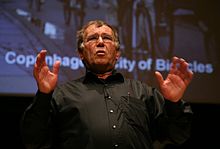|
Jan Gehl
Jan Gehl Hon. FAIA (born 17 September 1936, Copenhagen) is a Danish architect and urban design consultant based in Copenhagen whose career has focused on improving the quality of urban life by re-orienting city design towards the pedestrian and cyclist. He is a founding partner of Gehl Architects. BiographyGehl received a Masters of Architecture from the School of Architecture at the Royal Danish Academy of Fine Arts (KADK) in Copenhagen in 1960, and practiced architecture from 1960 to 1966. In 1966 he received a research grant from KADK to study " the form and use of public spaces"; his book Life between Buildings (1971) reports his studies of public life in public spaces, and develops his theories about how city planning and architecture influence public life. He became a professor of urban planning at KADK, and a visiting professor around the world.[1] He co-founded Gehl Architects in 2000 with Helle Søholt, held a Partner position until 2011, and remains a Senior Advisor.[2] As a "young architect working in the suburbs," Gehl married a psychologist and "had many discussions about why the human side of architecture was not more carefully looked after by the architects, landscape architects, and planners... My wife and I set out to study the borderland between sociology, psychology, architecture, and planning."[3] Influence Gehl first published his influential Life Between Buildings in Danish in 1971, with the first English translation published in 1987. Gehl advocates a sensible, straightforward approach to improving urban form: systematically documenting urban spaces, making gradual incremental improvements, then documenting them again. In 2012 the book is translated into a film by the same name, exhibited in a 24 meters curved room at the "New Nordic Architecture" exhibition Louisiana Museum of Modern Art and later at the Venice Biennale for Architecture.[4] Gehl's book Public Spaces, Public Life describes how such incremental improvements have transformed Copenhagen from a car-dominated city to a pedestrian-oriented city over 40 years. Copenhagen's Strøget carfree zone, one of the longest pedestrian shopping areas in Europe.The first section of Strøget was transformed to a pedestrian street on 17. November 1962, and Gehl used it as a living lab for observing peoples use of public space. Later his influential reports and books led to a collaboration with the City of Copenhagen and its political shift towards promoting predestrian zones and bicycling.[5] Gehl participates in and advises many urban design and public projects around the world:
Gehl credits the "grandmother of humanistic planning" Jane Jacobs for drawing his attention to the importance of human scale. “Fifty years ago she said – go out there and see what works and what doesn’t work, and learn from reality. Look out of your windows, spend time in the streets and squares and see how people actually use spaces, learn from that, and use it.”[15] Awards and distinctions
Selected publications
See alsoReferences
External links
|
||||||||||||||||||
